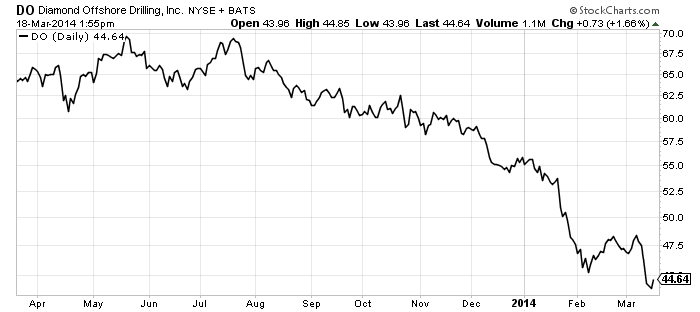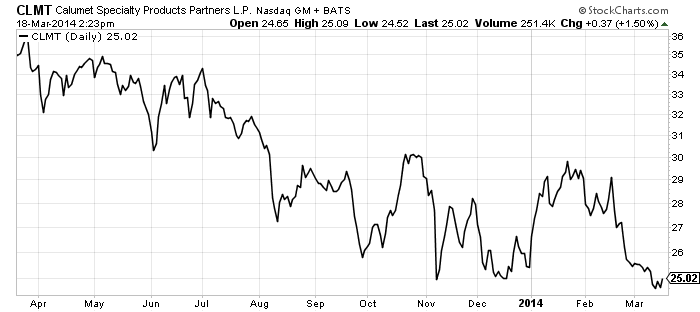 Hot or cold? When I’m a buyer, I’ll take cold every time. I’m naturally drawn to the market where investors are selling in droves. Bargains are rarely found in the hot market, where buyer enthusiasm runs rampant.
Hot or cold? When I’m a buyer, I’ll take cold every time. I’m naturally drawn to the market where investors are selling in droves. Bargains are rarely found in the hot market, where buyer enthusiasm runs rampant.
Two energy sectors are enticingly cold right now: offshore drilling and oil refining. I like both sectors, and I like two particularly frigid energy stocks within the sectors.
[ad#Google Adsense 336×280-IA]Offshore drillers are suffering from a glut of rig supply and a dearth of rig demand.
At least that’s the perception.
Credit Suisse expects that the large oil companies that drive offshore activity are unlikely to commit the requisite capital to keep rigs fully employed.
ExxonMobil (NYSE: XOM) could be foreshadowing the future.
The energy giant is expected to reduce capital spending roughly 6% to $39.8 billion this year.
From 2015 through 2017, ExxonMobil’s CAPEX is expected to ratchet down to $37 billion each year.
If other energy giants follow ExxonMobil’s lead, the dayrates on rigs could fall. Indeed, analysts at Barclays forecast that rates for ultra-deepwater drilling rigs – those that demand the highest rates – will drop by 16% over 2014.
This icy outlook has certainly put a chill on my favorite offshore driller, Diamond Offshore Drilling (NYSE: DO), which is down over 30% in the past 12 months.
 The above chart has warmed me to Diamond Offshore. I’ve seen this game played before: Wall Street deflates offshore drillers when utilization rates fall, and inflates them when rates rise. But the time to buy is when rates are expected to fall, because expectations are priced into the drillers’ shares.
The above chart has warmed me to Diamond Offshore. I’ve seen this game played before: Wall Street deflates offshore drillers when utilization rates fall, and inflates them when rates rise. But the time to buy is when rates are expected to fall, because expectations are priced into the drillers’ shares.
Negative expectations are surely priced into Diamond’s share price, perhaps excessively so. Diamond recently updated the status of its fleet, and it was “OK” – not spectacular, but not disastrous.
Despite the chilly outlook, Diamond is expected to earn $4.50 a share this year, and $5.85 next year. That produces a forward P/E multiple of 7.7, which is on the low end of the 10-year range of 5 to 38. At the same time, Diamond continues to earn enough to service its $3.50 annual dividend, which yields 7.8% – a multi-year high.
Refining is a similarly cold market, which is why Calumet Specialty Products Partners (NASDAQ: CLMT) is also in the icebox. Calumet refines oil and manufactures specialty waxes, lubricants, and oils. It sports a unit-price chart similar to Diamond Offshore Drilling. In other words, it sports a buying opportunity.
 Calumet’s low unit price is the byproduct of a perfect storm of problems.
Calumet’s low unit price is the byproduct of a perfect storm of problems.
The crack spread – the difference between the cost of oil input and the refined output – is at the forefront. The crack spread has declined through most of 2013. In the final quarter of 2013, it averaged $16 per barrel of oil compared to $30 per barrel in the same quarter in 2012. A declining crack spread leads to declining operating margins. By the end of 2013, Calumet’s operating margins had constricted to 2.3% from 6%.
Compliance costs have also contributed to Calumet’s woes. Because Calumet forgoes ethanol in refining many of its products, it must purchase credits – known as renewable identification numbers (RINs). The cost of these credits soared in 2013. Calumet spent $29.6 million on credits in 2013 compared to $3.8 million in 2012.
Major periodic maintenance costs, though necessary, were another inconvenience. In 2013, Calumet spent $67 million in maintenance and repairs to its refineries. This compares to $14.3 million in 2012. To be sure, much of this maintenance was scheduled, but the timing was suboptimal, given the fall in margins and rise in regulatory costs.
When these negatives are aggregated, the impact becomes apparent on the bottom line. In 2013, Calumet generated a $0.17-per-unit loss compared to a $3.50 profit the year before.
I don’t expect another perfect storm in 2014; I do expect cash-flow growth. Thanks to recent acquisitions – Royal Purple among them – and organic CAPEX, Calumet management forecasts a surge in cash flow. The partnership will generate between $190 and $215 million in additional adjusted EBITDA annually over the next three years.
If we add $200 million to the $242 million in adjusted EBITDA generated in 2013, we get $442 in adjusted EBITDA for 2014. This is more than enough to cover Calumet’s $2.74 distribution per unit, which yields over 11% on the current unit price.
Buying into the cold market isn’t for the faint of heart. But if you can muster the fortitude, it frequently leads to strong investment gains once investor sentiment thaws.
— Steve Mauzy
[ad#wyatt-income]
Source: Wyatt Investment Research
Disclosure: Stephen Mauzy owns Diamond Offshore Drilling shares.
